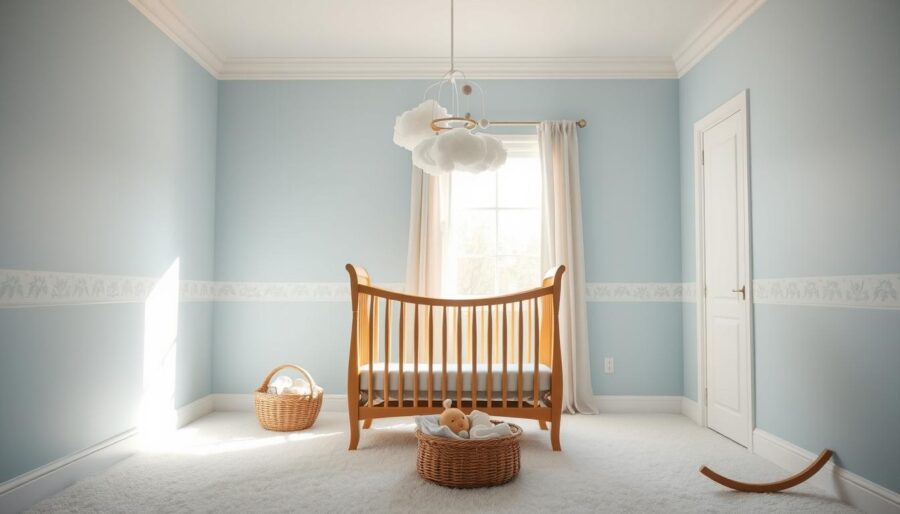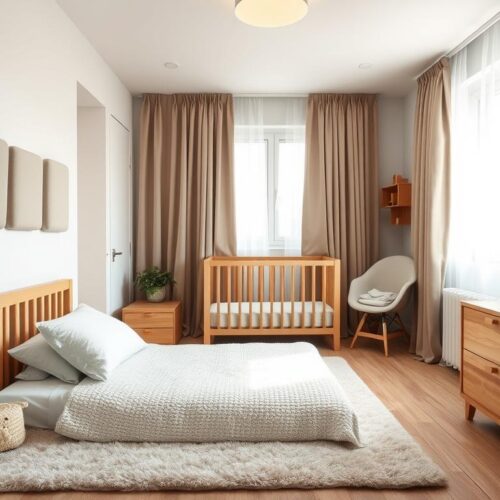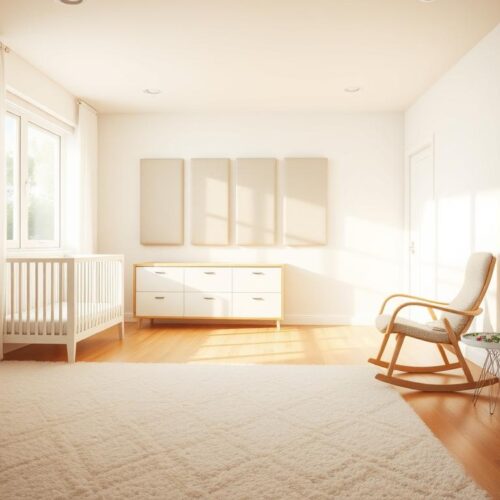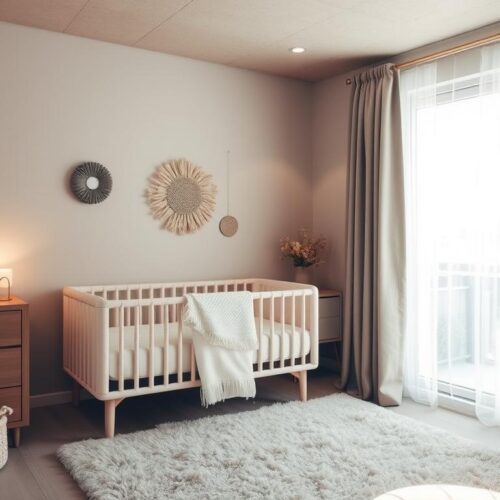Making your baby’s room peaceful is key for comfort and talking to them. Echoes in tiny rooms can mess with sleep and chatting with your baby. Knowing how to handle noise in small nurseries is vital for a calm space that helps everyone relax.
Good soundproofing can lower the echo. This lets you create a soothing space that’s good for you and your baby.
The Importance of Managing Echo in Small Baby Rooms
Managing echo in small baby rooms is crucial. It helps make sure babies feel calm and comfy. The World Health Organization says noise pollution is a big problem. It can mess with kids’ learning and feelings. Too much noise can disturb babies’ sleep. This is bad for their health and how they feel day-to-day.
That’s why soundproofing baby rooms is so important. It makes the room peaceful for babies. When parents fix echo and noise, babies sleep without being woken up. This quiet helps babies sleep deeper. Better sleep means babies are happier and grow well during these key years.
Common Sources of Echo in Small Nursery Rooms
When managing sound in small nurseries, knowing what causes echo is key. In tight spaces, sounds can bounce off hard surfaces. This creates echoes that might wake your baby or disrupt your day.
Here are the usual echo sources in small nurseries:
- Bare walls and ceilings made of smooth materials
- Hard floors, such as tile or concrete
- Large windows, especially those with glass
What you build with can make sound louder. For example, high ceilings and open spaces can make echoes worse. Fixing these areas helps control echoes. This makes your nursery more peaceful for your baby.
| Surface Type | Echo Potential | Suggestions to Improve |
|---|---|---|
| Bare Walls | High | Add wall fabrics or art |
| Hard Floors | Moderate | Use rugs or carpets |
| Ceiling Type | Moderate | Install acoustic panels |
| Windows | High | Add heavy drapes or curtains |
Tackling these echo causes can make your nursery much quieter.
Identifying Echo Problems in Your Nursery
Identifying echo issues is crucial for creating a peaceful environment for your baby. Begin by listening for distinct echoes or reverberations within the nursery. A simple way to test this is by clapping your hands.
Take note of how sound travels and whether it creates an echo off hard surfaces. If you can hear other sounds, like talking or TV, those may indicate severe echo problems.
When assessing nursery acoustics, pay attention to the placement of furniture and decor. Hard surfaces can amplify sound waves, leading to unwanted echo. Gaps around doors and windows may allow outside noise to invade, worsening the situation.
For accurate results, conduct your assessment during peak noise hours. This will help you gauge the true impact of echo on your child’s rest, ensuring you have a thorough understanding of any issues present.
| Assessment Method | Description |
|---|---|
| Clapping Hands | Test how sound travels and if it echoes. |
| Listen for Background Noise | Identify competing noises that indicate echo problems. |
| Inspect Surfaces | Look for hard surfaces that might amplify sound. |
| Check Gaps | Find gaps around doors and windows that could let in noise. |
Echo in Small Baby Rooms: Effective Solutions
Managing echo in small baby rooms is vital for peace. Several effective solutions can help. Using acoustic panels is one such method. They absorb sound, cutting down on echo. This makes them both stylish and functional for the nursery.
Adding soft furnishings like rugs and curtains improves room acoustics. Thick rugs stop sound from echoing off floors. Heavy curtains absorb sound, lowering noise even more.
Tall bookshelves filled with books not only look good but help with sound too. They scatter sound waves, reducing echoes. These tips offer simple but effective ways to make your baby’s room cozier.
By combining these methods, your baby’s room becomes a quieter, calmer place. Whether using one solution or several, reducing echo improves the nursery. It’s all about creating a tranquil environment for you and your baby.
Soundproofing Techniques for Nurseries
Creating a quiet space for babies is essential. Start with sealing doors and windows to keep noise out. This can be done with simple weather stripping or caulking. It helps reduce outside noise a lot.
Adding thick window treatments can also block noise. Consider soundproof curtains or shades. They block out noise and add style to your nursery.
If you have a budget for it, look into acoustic baffles or wall panels. They absorb sound well, making your nursery a peaceful place. These solutions are good investments for your child’s comfort.
Optimizing Acoustics in Small Spaces
Making a small room sound better needs careful planning with your furniture. Begin by putting soft items like sofas, pillows, and earmuffs in key spots. They act as sound blockers, making the room sound nicer.
To improve the room’s sound, layer rugs, furniture, and decorations on the walls. Choosing heavy and textured materials will help quiet down echoes, important in a tight space. Here are some tips:
- Place big upholstered pieces against walls to soak up sound.
- Hang heavy curtains on windows to cut down on echoes and keep out street noise.
- Mix different materials, like wood, fabric, and plush textiles for a better sound feel.
- Bring in acoustic panels or wall art that absorbs sound.
By using these ideas, you’ll make a cozy and peaceful spot for your baby. A well-thought-out nursery not only helps your baby sleep better. It also provides a relaxing environment for parents and their little ones.
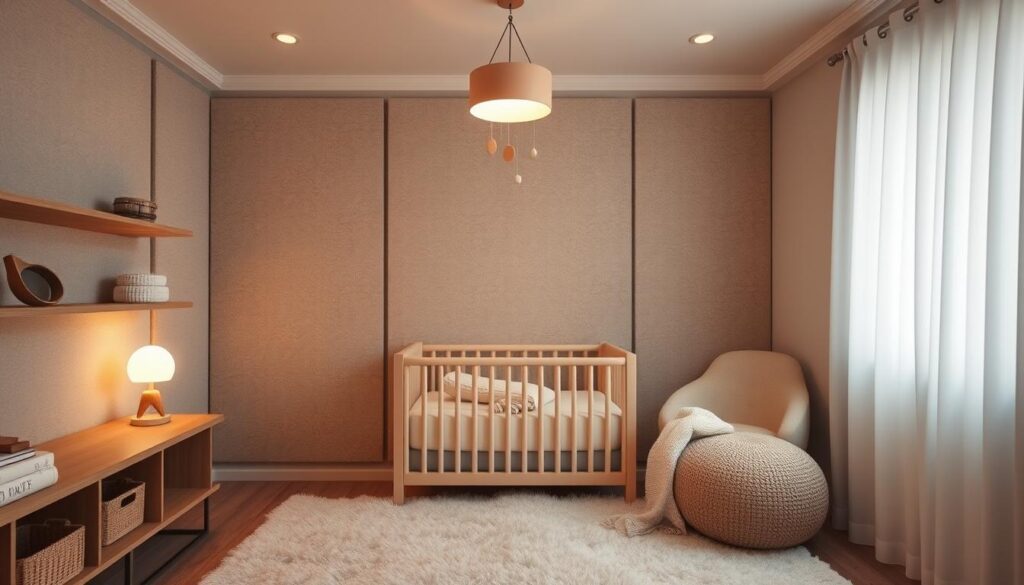
| Acoustic Enhancement Method | Benefits |
|---|---|
| Soft Furnishings | Absorb sound and reduce echo |
| Textured Materials | Diminish reverberations |
| Layered Rugs | Break up sound paths |
| Wall Décor | Enhance aesthetics and sound quality |
Shopping for the Best Baby Room Sound Solutions
Looking for the best baby room sound solutions? Start by focusing on products that reduce echo. Acoustic panels are great for soaking up unwanted noise, making your nursery quieter. Soundproof curtains not only block outside noise but also add style to the room.
Consider brands that specialize in acoustic materials. They use advanced technology for effective results. Look for carpets that absorb sound and furniture that also dampens noise. These choices keep your nursery looking good while cutting down on noise.
- Acoustic panels for your walls
- Soundproof curtains to keep noise out
- Carpets and rugs that absorb sound
- Furniture that includes soundproofing
- Decorative wall art that also absorbs sound
Striking a balance between practicality and style makes your nursery comfortable and trendy. Do your homework to find trustworthy products and brands for your baby’s room.
| Product Type | Benefits | Recommended Brands |
|---|---|---|
| Acoustic Panels | Reduces echo and enhances overall sound quality | Auralex,ATS Acoustics |
| Soundproof Curtains | Blocks outside noise and adds style | NICETOWN,Moondream |
| Sound-Absorbing Carpets | Cushions sound and adds warmth | Safavieh,nuLOOM |
| Furniture with Soundproofing | Multi-functional and stylish | IKEA,Wayfair |
DIY Techniques for Managing Echo
You don’t need an expert to manage echo in your nursery. Try some easy DIY echo control methods to improve sound quality. Begin with simple and cheap solutions for nursery sounds. Things like rugs, curtains, and soft furniture can catch sound waves, cutting down on echo.
Think about using soft art pieces that have fabric on them. They are better at stopping sound from bouncing back than hard surfaces are. You can also make your own sound-absorbing panels with foam and fabric. Just some glue and a bit of creativity can turn basic items into good sound absorbers.
By using these ideas, you can make your nursery quieter. This helps your baby relax and sleep better.
Hiring Professionals for Soundproofing Help
Facing complex echo issues in your nursery? Getting help from soundproofing pros is a great idea. They bring specialized knowledge and experience to the table. These experts can check out your space and find what makes sound problems worse.
They will come up with custom solutions for you. They know all about choosing and putting in the right soundproofing stuff. This includes materials that cut down on echo in tiny rooms. They can tell you how your room’s design affects sound, helping make things better for your baby.
Yes, hiring experts costs money, but it’s worth it. Their work makes your nursery peaceful. This means better sleep and a cozier place for your little one.
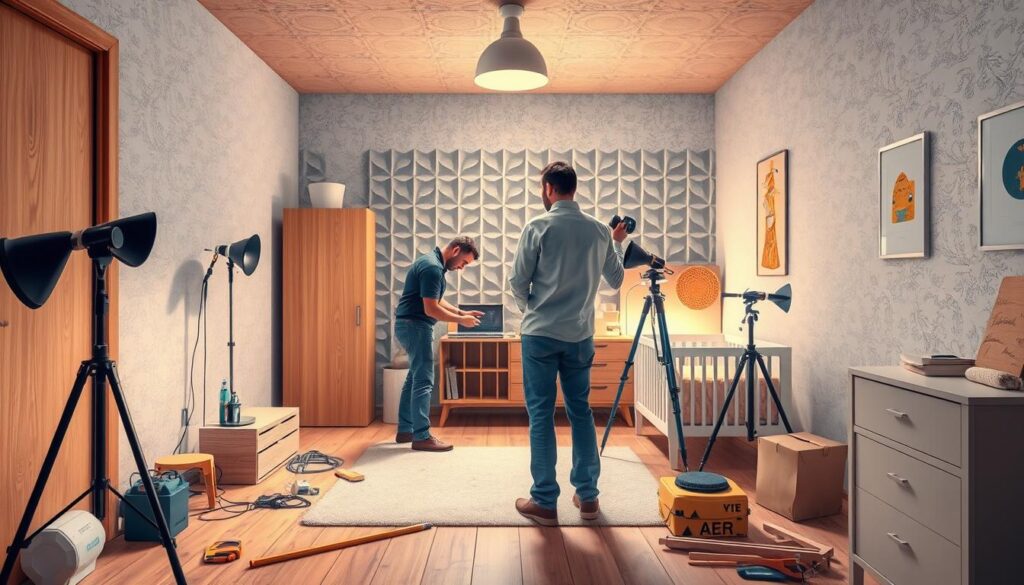
Conclusion
Dealing with echo in small baby rooms is key for a peaceful space. Using soundproofing and the right materials helps lower noise. This makes for a quiet and calm room.
It’s important to think about nursery acoustics for your child’s comfort and well-being. With expert advice and action, you can make a supportive and restful space. This helps your child sleep well and grow.
Putting effort into managing echo turns your baby’s room into a safe and calm place. By choosing these solutions, you create a better environment for your little one. A place that’s not just for sleep, but for growth and quiet moments too.

